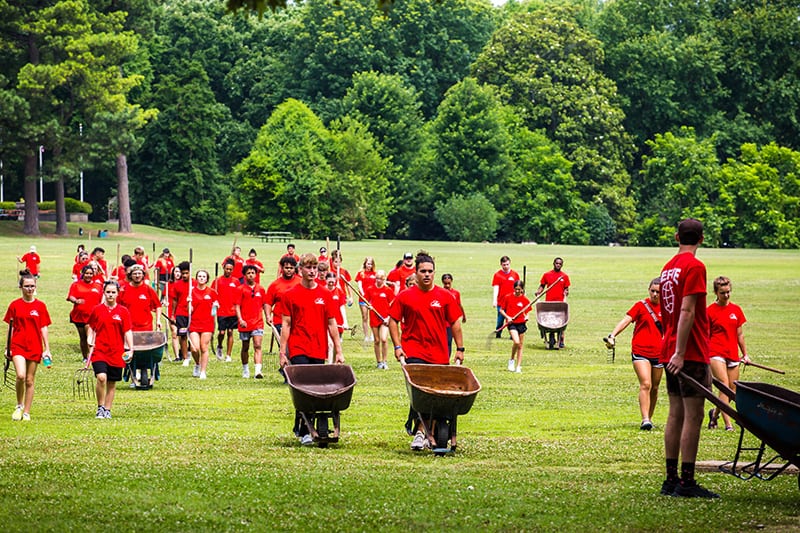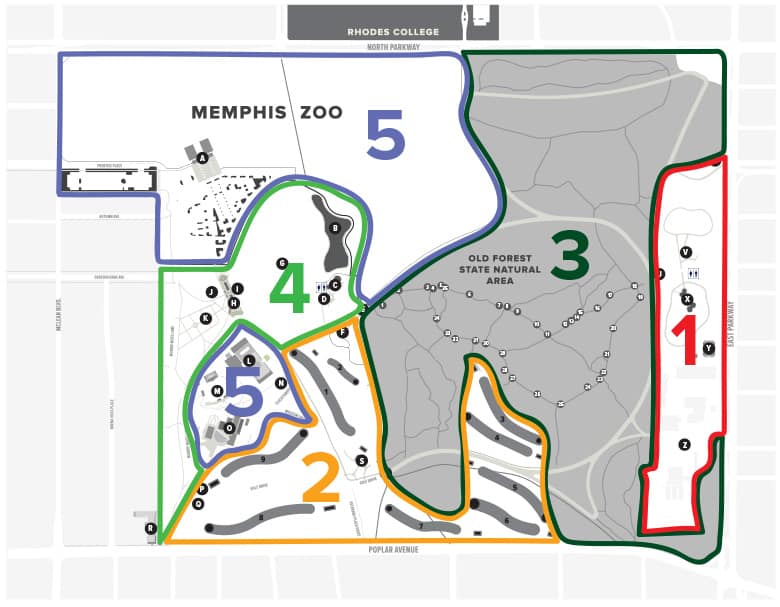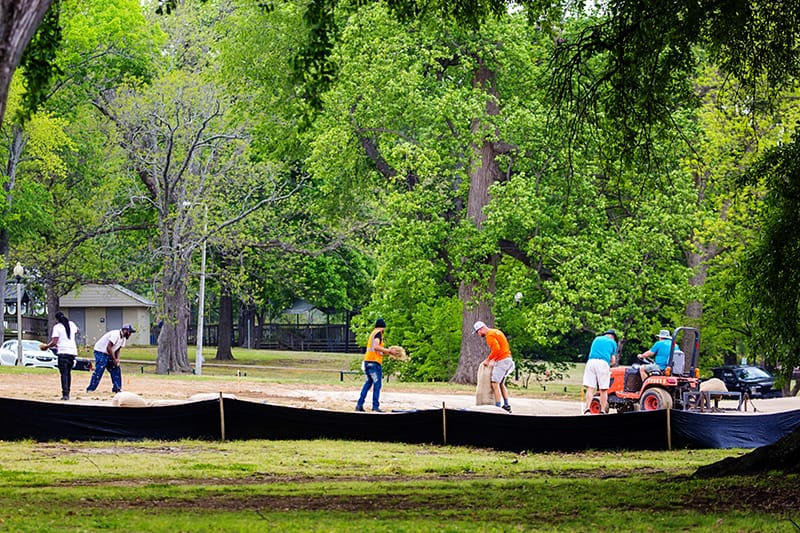Overton Park moves forward
This story originally appeared in our Fall 2021 newsletter.

As we celebrate 50 years since the progress of Interstate 40 through Overton Park was halted by a Supreme Court victory, Overton Park Conservancy is looking toward the next 50 years. Our comprehensive park planning process has been underway for a few years now, with much of our time devoted to conversations with you and your neighbors about what’s great about the park, what needs to be improved, and the ways the park could become an even more valuable asset to the community.
Our conversations revealed that park users were interested in more programming (including a potential welcome center) and more ways to extend a stay at the park (including active recreation areas, walking loops, availability of refreshments, and seating areas). Those discussions also revealed a deep attachment to virtually every element of the park, from the peaceful natural experience of the Old Forest, to the recreational gathering space of the Greensward, to the cultural institutions. This meant that we needed to focus on improving elements of these existing spaces and concentrate new programming and amenities in the 13-acre space being vacated by the City of Memphis at the park’s southeast corner.
With that in mind, we began looking at the park in five zones, making specific plans for each that enhance the park’s offerings as a whole. With so much changing in the park right now, we thought we’d update you on what’s happening in each of these zones.

Zone 1 includes the attractions on the park’s east side, from the Bike Gate plaza south to the corner of Poplar and East Parkway where the City’s 13-acre maintenance facility is currently located. Last fall, we conducted a public survey focused specifically on improvements to the existing amenities in Zone 1 and on potential additions within the southeast corner. More than 1,000 people responded that their top three goals for Zone 1 were preserving the natural quality of the existing landscape, providing areas of active recreation, and including programming that is welcoming to all Memphians. You can view some of the survey results on pages 16-19 of this newsletter.
Our team at Design Workshop has spent this year developing preliminary concepts based on this feedback, along with cost and revenue estimates. Beginning in early 2022, we’ll share these concepts, asking you to react to each element of the designs to determine whether you feel it’s a fit for Overton Park. This process will include a chance to interact directly with the design team. Make sure you’re signed up for our e-newsletter at overtonpark.org/email to learn when these forums will take place.
Zone 2 contains the park’s nine-hole golf course, which has been thoroughly reimagined by the team at King Collins Golf Course Design. With over $2 million in community support, the 2,250-yard, par-34 course makes the most of its unique setting, with the trees of the Old Forest framing native grasses, challenging swales, and passages through the beautiful stone bridges that cross Lick Creek.

The course will be rechristened Overton Park 9 when it reopens in 2022. Construction on the course has been completed, and a renovation of the Abe Goodman clubhouse will begin soon. Once the course reopens, it will continue to serve Memphians teaching their kids the game of golf or looking for a fun, short course that doesn’t take a full day to play. Having a King Collins course in the heart of Memphis will also attract golf enthusiasts from across the region.
Zone 3 comprises the Old Forest State Natural Area, where 2021 has brought a continued focus on removal of invasive plant species. Led by Bill Bullock, our volunteer crew has stayed on top of re-sprouting Chinese privet, worked to keep wisteria from spreading past the north end of the forest, and begun manually removing some English ivy.
Eric Bridges, our Director of Operations, continues his research into why the forest’s signature tree species are having trouble regenerating. He and his interns have wrapped up data collection on a study comparing how plants germinate beneath our native pawpaw trees vs. cherry laurel trees, which are native to the southeast but not to our area. The research aims to uncover whether cherry laurel is releasing chemicals that impede the growth of other plants, which would guide whether we prioritize removing it.
Moving into 2022, Eric and his team will focus on investigating whether the problem with regeneration begins at the seed germination phase. Over 96 plots, they’ll monitor the germination of sugar maple, tulip poplar, and Northern red oak seeds to see how many sprout and whether they survive over the next year. If the seeds germinate successfully, they’ll move on to testing whether the problem lies in the early growth phase by planting and monitoring seedling trees.
Zone 4 contains the areas on the west end of the park managed by Overton Park Conservancy, from the formal gardens and Veterans Plaza to the Greensward, Rainbow Lake (and its playground and pavilion), and Overton Bark. We anticipate that changes in this area of the park will focus less on new amenities and more on improving the existing features.
As Rainbow Lake Playground approaches a decade since our 2013 renovation, we’ve begun looking at features that need updating. For example, the metal spiral slide (which was not ADA-accessible and got very hot in the summers!) will be replaced by a wheelchair-accessible stage for imaginative play. The Big Green Mound will get a more durable surface, new climbing ropes, and an accessible route to the top. Rainbow Lake Pavilion also needs a serious rethinking, potentially including ideas like separating the restrooms from the picnic tables and gathering area, as they are at East Parkway Pavilion.
Rainbow Lake is a beloved park feature that presents continuous challenges due to its depth and construction. Every summer, we do battle with the algae blooms that pop up due to the high water temperature created by the lake’s 2.5-foot depth, its concrete lining, and the Memphis heat. In the next phase of our planning process, we hope to explore naturalizing at least part of the lake area, adding native plants and encouraging a healthy ecosystem while still providing excellent views of the water.



